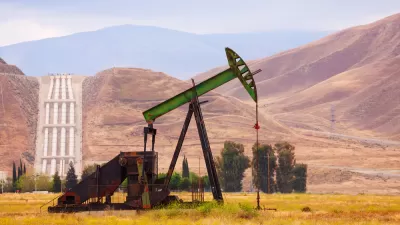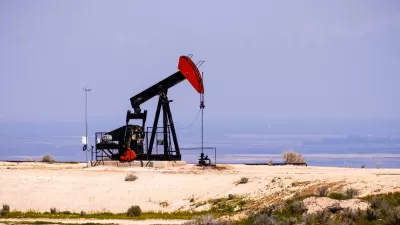Hydraulic fracturing may finally allow drillers to extricate oil from the Monterey Shale, creating a shale oil boom that could dwarf ones in states such as North Dakota. Environmentalists are digging in to limit the controversial practice.
Norimitsu Onishi reports on what is becoming the next front in the battle over the controversial oil extraction process known as fracking. With two-thirds of the United States’s total estimated shale oil reserves stored in its "complex geological formation," the stakes over efforts to tap California's Monterey Shale couldn't be higher. As Onishi notes, "covering 1,750 square miles from Southern to Central California, the Monterey Shale could turn California into the nation’s top oil-producing state and yield the kind of riches that far smaller shale oil deposits have showered on North Dakota and Texas."
"Established companies are expanding into the Monterey Shale, while newcomers are opening offices in Bakersfield, the capital of California’s oil industry, about 40 miles east of here. With oil prices remaining high, landmen are buying up leases on federal land, sometimes bidding more than a thousand dollars an acre in auctions that used to fetch the minimum of $2."
"The Monterey Shale has also galvanized California’s powerful environmental groups. They are pressing the state to strictly regulate hydraulic fracturing, or fracking, the drilling technique that has fueled the shale oil and gas boom elsewhere but has drawn opposition from many environmentalists. In December, the State Department of Conservation released a draft of fracking rules, the first step in a yearlong process to establish regulations."
“If and when the oil companies figure out how to exploit that shale oil, California could be transformed almost overnight,” said Kassie Siegel, a lawyer at the Center for Biological Diversity. “Fracking poisons the air we breathe and the water we drink. It is one of the most, if not the most, important environmental issue in California.”
FULL STORY: Vast Oil Reserve May Now Be Within Reach, and Battle Heats Up

Planetizen Federal Action Tracker
A weekly monitor of how Trump’s orders and actions are impacting planners and planning in America.

Congressman Proposes Bill to Rename DC Metro “Trump Train”
The Make Autorail Great Again Act would withhold federal funding to the system until the Washington Metropolitan Area Transit Authority (WMATA), rebrands as the Washington Metropolitan Authority for Greater Access (WMAGA).

The Simple Legislative Tool Transforming Vacant Downtowns
In California, Michigan and Georgia, an easy win is bringing dollars — and delight — back to city centers.

The States Losing Rural Delivery Rooms at an Alarming Pace
In some states, as few as 9% of rural hospitals still deliver babies. As a result, rising pre-term births, no adequate pre-term care and "harrowing" close calls are a growing reality.

The Small South Asian Republic Going all in on EVs
Thanks to one simple policy change less than five years ago, 65% of new cars in this Himalayan country are now electric.

DC Backpedals on Bike Lane Protection, Swaps Barriers for Paint
Citing aesthetic concerns, the city is removing the concrete barriers and flexposts that once separated Arizona Avenue cyclists from motor vehicles.
Urban Design for Planners 1: Software Tools
This six-course series explores essential urban design concepts using open source software and equips planners with the tools they need to participate fully in the urban design process.
Planning for Universal Design
Learn the tools for implementing Universal Design in planning regulations.
Smith Gee Studio
City of Charlotte
City of Camden Redevelopment Agency
City of Astoria
Transportation Research & Education Center (TREC) at Portland State University
US High Speed Rail Association
City of Camden Redevelopment Agency
Municipality of Princeton (NJ)




























